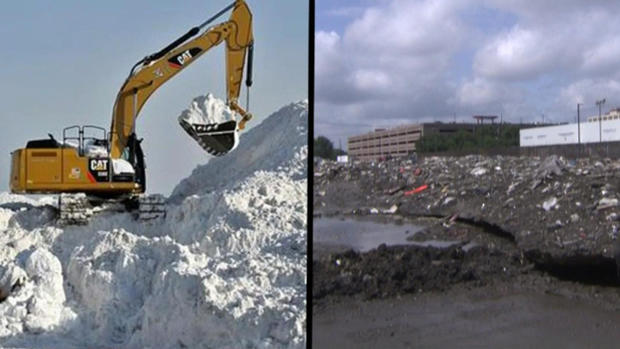Why Is That Southie Snow Pile STILL There?
Find Eric Fisher on Twitter and Facebook
Plows were removed from trucks. The road salt was swept away. Flowers started to bloom, 4th of July fireworks lit up the sky, and summer vacation began. And yet, here we are in July, and a large pile of snirt (snow-dirt) continues to stare at us in Southie. You'd be hard pressed to realize it as you walk by. The snow pile is camouflaged as a hybrid of glacier and landfill, slowly revealing the trapped remnants of winter 2015. When that road cone was scooped up - it came here. When the newspaper was snatched by a plow before you could read it - it came here. And now, like John Candy unable to finish the gristle of his Old 96-er plate, we're left with a filthy heap of snowy remains.
Chet Ripley wanted nothing to do with those leftovers in 'The Great Outdoors'
How is this possible? It hasn't been a scorching summer, but we've had our fair share of warm days. Rainstorms have come and gone. And yet the snow somehow holds its own and defies the odds. Well science can give us a glimpse into the staying power of this meteorological monument.
A) That Was a Whole Lot of Snow.
First, the obvious. Record snow fell in the winter of 2014-15, covering the region in a depth not seen before in the modern era. 110.6" was the final tally in the city of Boston. And although it wasn't a particularly wet or dense snow (most of our storms had dry, fluffy snow to help produce those big totals) it became a very solid mass when piled up at the snow farm. Bucket-loaders climbed all over it, dump trucks scaled it, and so you ended up with a tight block of concentrated ice instead of the usual pile of snow that might end up on the sides of your driveway after you shovel. This helped to reduce air pockets within the snow, and the pockets that do exist couldn't move around much to transfer heat. Plus, the chemical bonds became stronger as the pile transitioned from a fluffy snow to an icy matrix. The work was a tall order for Mother Nature from the get-go.
B) A Very Dry Spring
After that insane snow blitz, all went quiet in New England. Other than Patriot's Day (thanks for that, nature) - we barely had a drop of rain in April or May. It was a record dry May for most of the area. The issue here is that water can trickle in and penetrate these big masses of snow and ice, helping to deliver heat and quicken up the melting process. But without much action, this variable wasn't much of a factor. The rain business picked up in June and finally helped to make some inroads.
May rainfall was 5-15% of average, with record lows in some New England cities/towns. Source: NOAA
C) Energy Requirements - More Heat Please!
You'd think that as soon as temperatures climbed above freezing, the snow and ice would melt. Not so, thanks to the latent heat of fusion. 'Latent heat' is sometimes referred to as 'hidden heat' because it isn't required or released unless a phase change occurs. When water vapor condenses, heat is released into the air around it. The opposite is true for melting ice. Significant energy is required to change a solid to a liquid, beyond the amount of energy that it takes to raise the snow pile to a temp of 32F. Think about how long it takes for a pile of ice cubes from your BBQ cooler to melt, even on a hot summer day. You're constantly in need of enough energy to not only raise the surface of the ice to 32F, but to then break the bonds and change that solid into a liquid.
Source: http://ffden-2.phys.uaf.edu/212_spring2011.web.dir/Quinn_Verfaillie/heat.html
This huge pile in Southie is also helping to insulate itself over time. The interior is still quite cold with very little air or heat penetrating into its core. The sun can only go to work on it from the outside in (although some melting likely happens at the very bottom that's in contact with the lot below). And since it was so large, it was constantly cooling the air around it. As the bonds break and ice turns to liquid (and then to a gas), energy drawn from the air around it leads to a cooling effect around the snow. So even if the air temp at Logan is 85F, the air in the immediate few inches around the snow would be sharply cooler.
Source: http://hyperphysics.phy-astr.gsu.edu/hbase/thermo/phase.html
D) Surface Area - Piles Melt Slower
Much like the shaved ice in your drink will melt faster than a single large cube, a pile of snow will melt slower than if it were spread out with a larger surface area. Surface area to volume ratio is a big key to how fast snow will disappear. You may have noticed some ball fields spreading out their snow over larger areas this spring to try to clear them in time for the upcoming season. Some took it to the next level and also added black sand to the snow to absorb more solar radiation and expedite the process.
Since the Southie pile was stacked up to help preserve space (we were running out of it) its surface area was quite low relative to its total volume. This dramatically slows down the melting, and is the same as the pile where you kept throwing snow all winter next to the front door lasting longer than the snow in your lawn.
E) Boston Is A Cool Spot
If I were a snow pile, I'd pick Boston Harbor as a great place to live by. That might not be the case in the depths of winter when coastal communities tend to be milder, but it's certainly the case in spring and early summer. Sea breezes kick in along the cool ocean, and in general Boston is one of the coolest spots on the map March - June. You've heard (and groaned) when we talk about backdoor cold fronts, and they arrive at the coast first. In summary - there are many fewer hours of warm temperatures in the sun along the waterfront than there are inland. Your chances of snowy survival are higher in Southie than at Shopper's World in Framingham.
So when will it finally disappear? That's tough to say. At any point the city could have gone ahead and gotten rid of this beast. You'd just need to spread it out in the field and it would be gone in a few days. But our honorable Mayor has asked everyone to send in their guesses using the hashtag #BOSMeltNow. I'd wager another 2 weeks before we rid ourselves of this landmark. There's some decent summer heat in the forecast over the next 5 days, and humidity has started to become more of a part of our daily routine.
I think that at the very least we can all agree that it's a good thing the city didn't decide to dump this bad boy in the harbor. While the dirty snow is still melting, it's melting at a very gradual rate and can at least be diluted over time. And now that we can all see what's trapped inside a massive snow bank, it's a good visual as to why there are environmental concerns with just throwing it in the water. All of this rubbish and the chemicals picked up from the road would go into the ocean at once. So we have an unsightly pile, but the city is siphoning off the trash as it is released by the berg and soon enough all that will be left is the memory.










